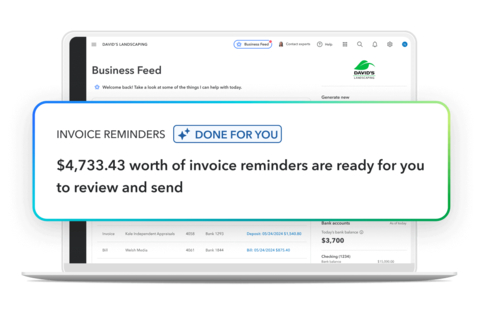
QuickBooks Just Got AI: But Does It Solve Your Ecommerce Accounting Challenges?
Contents
TLDR
QuickBooks just added AI that can draft reports, answer accounting questions, and automate reconciliation tasks with a simple prompt.
Sounds perfect for ecommerce sellers drowning in spreadsheets, right? Not quite.
AI cannot analyze data that never made it into QuickBooks. It cannot reconcile fees you forgot to import or fix inventory counts that drifted out of sync three months ago.
For sellers managing Shopify, Amazon, eBay, and POS systems, the problem was never a lack of AI intelligence. The problem is getting accurate, complete data into QuickBooks in the first place.
This guide breaks down what QuickBooks AI covers, where it falls short, and how to choose the right automation for your business.
What is QuickBooks AI?
QuickBooks launched Intuit Assist, a generative AI-powered financial assistant embedded directly into QuickBooks Online and the mobile app.
What Intuit Assist can do

AI-powered invoice reminders in QuickBooks
Intuit Assist can turn conversations and documents into invoices or estimates by allowing business owners to forward emails, upload photos of handwritten notes, or scan documents. The system analyzes unstructured data from emails, PDFs, and handwritten notes to auto-generate draft invoices, estimates, expenses, and receipts.
QuickBooks now includes three AI agents:
- An Accounting Agent that keeps books clean and flags items needing approval.
- A Payments Agent that facilitates faster payments and bill management.
- A Finance Agent that analyzes and summarizes financial data.

Finance Agent in Intuit Assist
The platform uses intelligent automation to speed up expense categorization with improved accuracy and can automatically match and record transactions based on how you previously categorized income and expenses.
Suggested read: How Ecommerce Automation Saves Time and Reduces Errors in QuickBooks
The ecommerce accounting challenges QuickBooks AI misses
QuickBooks AI handles general accounting well, but ecommerce creates unique complexities it cannot parse. Three critical gaps remain:
Marketplace fee complexity
Each platform, like Amazon, Walmart, Etsy, and eBay, charges different fees, from FBA storage and advertising to transaction and listing fees. QuickBooks AI cannot break down these settlement reports or allocate fees by SKU.
Without ecommerce automation, sellers must manually calculate and post each fee type, increasing the risk of errors and hiding true margins.
Multi-store reconciliation
Shopify deposits arrive two to three days after orders, Amazon pays out every 14 days with fees already deducted, and PayPal holds funds with rolling reserves. Each channel uses different reporting formats.
What’s more, manual reconciliation can eat up hours per week for multichannel sellers. QuickBooks AI does not consolidate these timing differences or map orders to deposits automatically.
Returns and inventory chaos
Returns affect both revenue and inventory at once. QuickBooks AI does not post credit memos, update inventory after returns, or link refunds to original orders. This doubles the effort required for accurate books and increases inventory count errors.
These gaps require purpose-built ecommerce automation that syncs data before it reaches QuickBooks. Platforms like Webgility connect directly to sales channels, parse marketplace settlements automatically, reconcile multi-channel payouts, and handle returns with complete order-level detail so your QuickBooks data stays accurate from the start.
Choosing the right accounting automation platform determines whether QuickBooks AI enhances your workflow or works with incomplete data.
How to evaluate ecommerce accounting automation
Generic software metrics miss what matters for ecommerce. These six criteria determine whether accounting automation solves your operational challenges:
Real time vs. batch sync
Real time means updates within 15 minutes of each transaction. This prevents overselling and keeps inventory accurate across all channels. Batch sync creates gaps that can lead to costly errors.
Order-level vs. payout-level posting
Order-level detail lets you see SKU profitability and avoid margin leaks. Payout summaries hide which products drive profit after fees.
Multichannel and POS support
Your automation should connect to all ecommerce platforms, marketplaces, POS systems, and payment processors you use, not just one or two.
Returns/refunds automation
Look for automatic credit memo creation, inventory restocking, and refund tracking linked to original orders.
Inventory and SKU-level accuracy
Real-time, SKU-level tracking across channels prevents stockouts and overselling. Bundle and kit support is essential for complex catalogs.
Suggested read: How Automation Improves the Customer Experience
Scalability as order volume grows
The system must handle 10x your current order volume without slowing down or breaking.
For example, Webgility’s real-time sync means inventory updates instantly across Shopify, Amazon, and QuickBooks. This prevents overselling and manual errors. If your current solution cannot check all these boxes, manual work and reconciliation headaches will persist.
Decision framework: When to use QuickBooks AI alone and when to add automation
If you run a single channel and low volume, QuickBooks AI may suffice. For multichannel, high-volume, or inventory-heavy businesses, an automation layer like Webgility is essential.
|
Business scenario |
Solution tier |
Why this works |
|
Single channel, <500 orders/month |
QuickBooks AI alone |
Handles basic accounting and invoicing |
|
Multichannel, >500 orders/month |
Add Webgility automation |
Automates reconciliation and inventory sync |
|
Complex inventory, multiple locations |
Add Webgility automation |
Real-time, SKU-level tracking across channels |
|
Need order-level profitability analysis |
Add Webgility automation |
Captures every order, fee, and return |
Table 1: Recommended solutions by business scenario
If you need real-time data sync with QuickBooks, marketplace payout reconciliation, or order-level detail, Webgility extends QuickBooks AI to cover these gaps. Growth-focused brands benefit from automating early, before manual work becomes a bottleneck.
Real-world example: How Epic Mens scaled with QuickBooks AI + Webgility
Epic Mens, a men’s apparel retailer, faced the classic multichannel challenge: manual entry capped their growth at 6,000 orders per month, and inventory counts happened only twice a year. Owner Shen Li realized that scaling required automation from day one.
After evaluating custom code and other tools, Epic Mens chose Webgility for its real-time inventory sync and deep QuickBooks Enterprise integration.
With Webgility, Epic Mens scaled to 15,000 orders per month, saved over 80 hours a week, and now runs weekly inventory counts. A team of four manages triple the order volume, and the business achieved 42% year-over-year growth. Every order, fee, and return is posted automatically.
QuickBooks AI is a leap forward for general accounting, but ecommerce automation closes the gap for multichannel growth. Audit where manual work still slows your team, then automate what matters most.
Thousands of ecommerce brands trust Webgility to keep every channel, payout, and inventory count in sync, so they can scale without the accounting bottleneck.
Book a demo today.
Frequently asked questions (FAQs)
Will QuickBooks AI replace ecommerce automation tools?
No. QuickBooks AI handles general accounting, but ecommerce automation tools like Webgility automate reconciliation, inventory sync, and order-level posting for multichannel sellers.
Can I use Webgility with QuickBooks AI?
Yes. Webgility is an official Intuit partner and integrates directly with QuickBooks AI, supporting multichannel ecommerce out of the box.
How does Webgility compare to A2X and Synder?
Webgility provides real-time, order-level, and inventory sync across all channels. Competitors like A2X focus on payout summaries and have limited POS support.
What about implementation and support?
Webgility offers onboarding and ongoing support for QuickBooks users, ensuring a smooth transition and reliable automation.
Yash Bodane is a Senior Product & Content Manager at Webgility, combining product execution and content strategy to help ecommerce teams scale with agility and clarity.



.png?width=56&height=56&name=image%20(1).png) Yash Bodane
Yash Bodane


